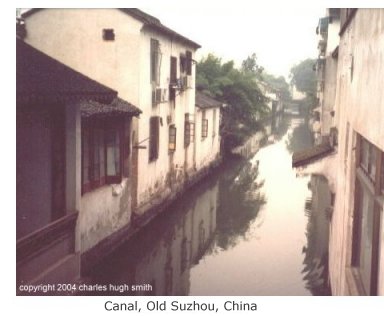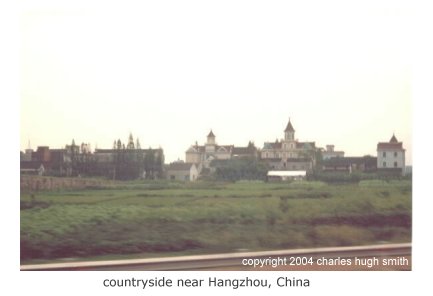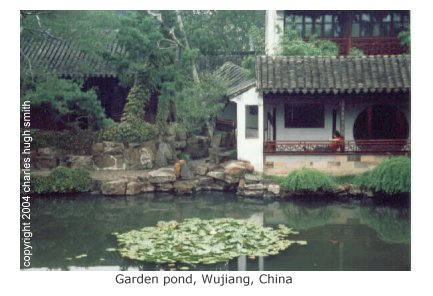

|
| weblog/wEssays | home | |
|
China and India: Five Flies in the Ointment: Ecology, Culture, Caste, Corruption and Capital August 18, 2005 A fascinating overview of China and India's future has been assembled by BusinessWeek Online. The various essays cover well-tilled ground, but the commentaries of the Indian and Chinese experts on the panel discussions are of interest.  The basic story has been oft-told: China and India are set to grow rapidly for decades, and will eventually
overtake or at least equal the U.S. as an economic (and presumably political) superpower. There are potential
obstacles--environmental concerns, possible financial and political upheaval, even war--but these are presented
more for "balance" than as actual obstacles which will derail the whole enterprise.
The basic story has been oft-told: China and India are set to grow rapidly for decades, and will eventually
overtake or at least equal the U.S. as an economic (and presumably political) superpower. There are potential
obstacles--environmental concerns, possible financial and political upheaval, even war--but these are presented
more for "balance" than as actual obstacles which will derail the whole enterprise.
Interestingly, all the essays and commentaries except one avoid mentioning the real "flies in the ointment," the entrenched, intractable problems which confront both nations: Ecology, Culture, Caste, Corruption and Capital. Conclusion: the era of cheap oil is nearing an end, and this fact will hinder the development of all industrializing countries. Another point raised by only one commentator is that China has been subsidizing its industrialization with cheap financing (loans to government-owned companies which will never be repaid) and government-financed infrastructure.  Since
China's rapid industrialization has poisoned its environment and its people, then China has basically underpriced the goods
it has produced. That is, if the cost of scrubbing the pollution pouring from coal-fired plants were priced into
the goods, they would cost appreciably more. And since China will eventually have to
clean up its polluting industries or pay the price in the decline of its workers' health, then the "real cost"
of Chinese-made goods will have to rise.
Since
China's rapid industrialization has poisoned its environment and its people, then China has basically underpriced the goods
it has produced. That is, if the cost of scrubbing the pollution pouring from coal-fired plants were priced into
the goods, they would cost appreciably more. And since China will eventually have to
clean up its polluting industries or pay the price in the decline of its workers' health, then the "real cost"
of Chinese-made goods will have to rise.
In the same way, any comprehensive overview of India and China's economy has to look objectively at cultural issues such as caste, rights of women, corruption, how the rule of law actually operates, etc. For instance, how can India ever claim to be utilizing its citizens' full talents when half the population--the female half--is largely denied equal opportunity? And how can India proceed beyond enriching the top 1% of its people when 160 million Dalits ("untouchables") are marginalized? As for rule of law, it exists in name only if you happen to be trapped in the nightmarish reality of Indian "justice" in which cases take years to even reach trial. (The American justice system is nightmarish, too, of course, but if you had a choice, you'd certainly pick the U.S. system.) As for China, the more you know about pirating and corruption in China, the less sanguine you are about the possibilities of both plagues being eradicated by some new statute. Conclusion: Cultural impediments such as caste, sexism and corruption are obstacles to economic supremacy which cannot be mandated out of existence by laws or policies. 
Conclusion: The top 1% of these societies are elevated as models for the other 99%, but caste and corruption render this a flawed analogy. The software engineers of Bangalore are held as models for all of India, but the entire software industry in India employs less than a million workers, in a country of 1.2 billion. The Chinese yuppies glorified in depictions of Shanghai indulgences such as nightclubs and penthouses are similarly a razor-thin cream on a largely impoverished society.  But then capital flows out of countries as well, and while China is currently enjoying huge inflows of foreign
capital, history suggests such a tide of capital can recede as quickly as it flowed in once returns are better
elsewhere. While the Chinese people are prodigious savers, and the central bank sits on foreign reserves of $600
billion, the fact remains that bad bank loans promulgated by the same central government are by most accounts
at least equal to the entire reserves--$600 billion or more. (See
my essay on China's future for more information and links on the true state of China's finances.) By strict
accounting, China is essentially broke; the illusion of big reserves is kept in place by hiding the true size of
bad debt in the system.
But then capital flows out of countries as well, and while China is currently enjoying huge inflows of foreign
capital, history suggests such a tide of capital can recede as quickly as it flowed in once returns are better
elsewhere. While the Chinese people are prodigious savers, and the central bank sits on foreign reserves of $600
billion, the fact remains that bad bank loans promulgated by the same central government are by most accounts
at least equal to the entire reserves--$600 billion or more. (See
my essay on China's future for more information and links on the true state of China's finances.) By strict
accounting, China is essentially broke; the illusion of big reserves is kept in place by hiding the true size of
bad debt in the system.
The basic model of fast economic growth in the post-war era has been the export-driven economies of Japan, Taiwan and South Korea. In this model, domestic savers generated large amounts of capital which the central banks loaned to corporations at low rates to fuel their worldwide expansion. While that seemed to work wonders without the need for foreign capital, the downside of such a policy is visible in the 15-year malaise of the Japanese economy. Without the pressures of competitive capital, there has been no political or financial will to tear down the structural barriers which have been slowly strangling Japan's economic vibrancy. Growing to superpower status without risking the whims of foreign capital is a nice dream, but foreign capital is also what keeps an economy honest, transparent and competitive. The current boom in China and India is also widening the gap between the haves and the have-nots--a situation we share in the U.S. The question is: are the cultures of India and China truly able to grow a culture of meritocracy and opportunity? While the gap is widening statistically in the U.S., there are so many examples of regular folks making immense fortunes in the U.S.--Oprah Winfrey, Steve Jobs, Larry Ellison, Bill Gates, Warren Buffet, George Lucas, et. al.--that it is hard to make the case that upward mobility is dead in the U.S. Any study of the economies of China and India should note that a culture of injustice and inequality drives convulsions like the Cultural Revolution or the great urban riots in the U.S. in the late 60s. All the repressed injustices of a society tend to boil over violently once the dream of upward mobility is revealed as false. Some have pointed to the rise of the U.S. as an industrial power as an analogy to the current rise of China and India. But it is a false analogy in one key manner: the U.S. took in tens of millions of Europe's abject poor, as the European economies failed to create employment for their deprived and economically immobile citizens. But the hundreds of millions of poor Chinese and Indians cannot immigrate to the U.S. or elsewhere, and so those country's failures to offer employment opportunities to their poor will fester in-country. There is no longer a safety valve in "The New World;" we have only this one old world of diminishing forests and oil for all of us. * * * copyright © 2005 Charles Hugh Smith. All rights reserved in all media. I would be honored if you linked this wEssay to your site, or printed a copy for your own use. * * * |
||
| weblog/wEssays | home |